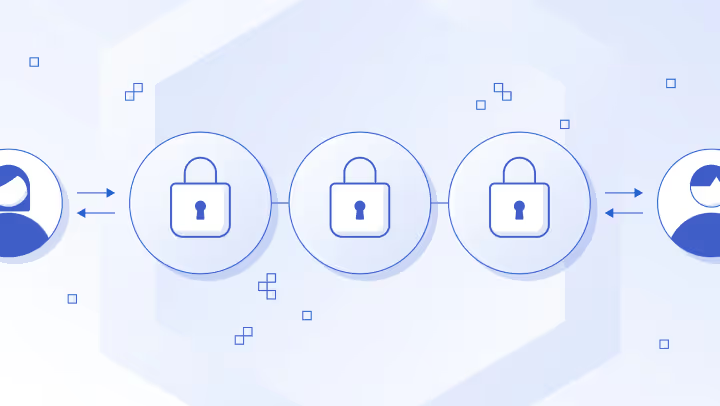Cross-Chain vs. Multi-Chain
Cross-chain dApps function across multiple different smart contracts deployed across multiple different blockchains, while multi-chain dApps are deployed in multiple individual versions across distinct networks.
Cross-chain dApps function across multiple different smart contracts deployed across multiple different blockchains, while multi-chain dApps are deployed in multiple individual versions across distinct networks.
The continually rising demand for blockspace has led to the Web3 application layer existing across hundreds of different blockchains, layer-2 networks, and appchains. This reality has brought forth two new terms—cross-chain and multi-chain. In this article, we’ll define what they mean and outline their differences and distinct benefits.
<div class="educational-divider sections-divider"></div>
A Brief History of the Multi-Chain Ecosystem
Ethereum was the first smart contract blockchain to support fully programmable decentralized applications, and it rapidly kickstarted its adoption through its growing network effects. The initial adoption of smart contracts took place on Ethereum, with dApps like Compound, MakerDAO, Uniswap, EtherDelta, and others emerging as a new way to use financial services entirely through on-chain infrastructure.
However, the rising demand for Ethereum smart contracts has increased demand for the network’s blockspace, leading to elevated network transaction fees. While Ethereum mainnet continues to be one of the most secure smart contact networks, many users have begun to seek lower-cost alternatives, while some builders have seen an opportunity to develop alternative smart contract platforms and take a portion of Ethereum’s market share. This dynamic has led to the rise of the multi-chain ecosystem.
<div class="educational-divider sections-divider"></div>
What Is Multi-Chain?
In a multi-chain environment, each dApp instance consists of an isolated set of smart contracts with no connection to other applications on other blockchains.
The availability of new on-chain environments through the evolution of the multi-chain ecosystem has increased the total aggregate throughput of the smart contract economy, leading to the onboarding of more users, who are able to transact at a lower cost. Furthermore, each network offers its own approach to scalability, decentralization, mechanism design, consensus, execution, data availability, privacy, and more. In the multi-chain ecosystem, all of these different approaches can be implemented and battle-tested in parallel to push forward the development of Web3.
However, the dawn of the multi-chain environment did bring its own drawbacks. Isolated app deployments lead to decreased capital efficiency, as liquidity is fragmented between isolated applications, with no movement between them. Furthermore, the beneficial effects of permissionless composability are hindered as smart contracts become increasingly siloed across hundreds of distinct networks.

If a project wants to follow user demand and remain competitive in a constantly shifting multi-chain environment, it has to deploy its application on multiple blockchains, creating increased friction for the end user. In addition, individual dApp deployments take time to develop and maintain, taking up precious development resources that otherwise could be spent improving the core functionality of the dApp.
Any application that requires a single source of truth on state, such as an on-chain domain name system with a central registry, is difficult to implement in a multi-chain context. If multiple registries are deployed across multiple networks, then the same name could be registered multiple times across different chains with different owners. As such, applications that require a global state of consistency are often deployed to just one network.
With that said, there can be additional benefits to multi-chain deployments. Billions of dollars have been lost to hacks that were the result of unsecure cross-chain token bridges. If a cross-chain smart contract relies on a cross-chain bridge with suboptimal security, funds can be at risk even if the underlying blockchain infrastructure is secure. In a multi-chain deployment with distinct and isolated smart contracts, the impact of vulnerabilities can be limited to individual deployments.
<div class="educational-divider sections-divider"></div>
What Is Cross-Chain?
Cross-chain functionality enables developers to build natively cross-chain applications where a single unified dApp instance can function across multiple different smart contracts deployed across multiple different blockchains instead of having to deploy multiple individual versions across distinct networks.

In a cross-chain context, different smart contracts on different chains perform different tasks, yet all stay synchronized and support a single use case in a unified application. This enables developers to leverage different networks to take advantage of their unique benefits.
For example, a developer could create a decentralized application that uses all of the following networks:
- A censorship-resistant blockchain for tracking asset ownership.
- A high-throughput blockchain for facilitating low-latency token swaps.
- A privacy-preserving blockchain as the identity layer.
- A decentralized storage network for metadata storage.
Cross-chain interoperability is critical for a more integrated Web3 ecosystem as well as for creating more connections between the Web3 economy and existing Web2 infrastructure. By enabling cross-chain smart contracts, cross-chain interoperability solutions reduce fragmentation in the ecosystem and unlock higher capital efficiency and better liquidity conditions. If you’d like to learn more about the benefits of cross-chain infrastructure, read What Is Cross-Chain?.
<div class="educational-divider sections-divider"></div>
Creating a More Interconnected Web3 Ecosystem Through Cross-Chain Messaging
While cross-chain smart contracts represent a major paradigm shift in how decentralized applications can be created, the vast majority of blockchain networks operating at scale are siloed. The Cross-Chain Interoperability Protocol (CCIP) is an open-source standard for cross-chain communication involving arbitrary messaging and token transfers. As a natively blockchain-agnostic protocol, the Chainlink Network is integrated across a wide range of blockchains and layer-2 networks, making it well-positioned to support the multi-chain ecosystem’s shift to cross-chain smart contracts.
A fully realized cross-chain environment can unlock highly scalable and fully fledged cross-chain applications that offer a user experience that billions of users are familiar with in the Web2 world while upholding the benefits of immutability and trust-minimization as fundamental standards of this new Internet paradigm.
To learn more about Chainlink, visit the Chainlink website and follow the official Chainlink Twitter to keep up with the latest Chainlink news and announcements.











